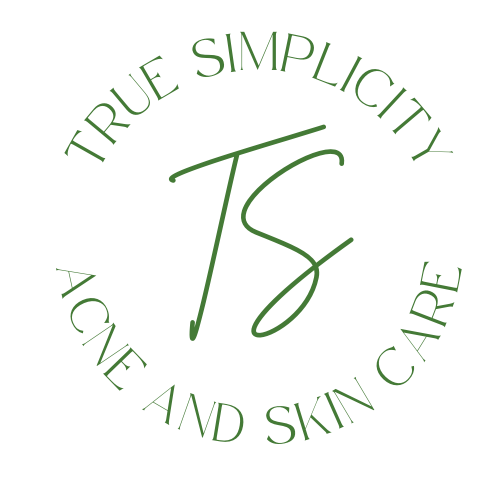What is Acne?
For most people, acne is an inherited condition of the pores. When someone is prone to acne, their pores clog with dead skin cells much faster than normal. Healthy pores shed about one layer of dead skin cells per day inside the pore, but acne-prone pores shed up to five layers of dead skin cells per day. The body just can’t keep up with keeping the pore clear. Technically, this is called “retention hyperkeratosis”–dead skin cells shedding more quickly than the pore can expel them.
Healthy Pore
As the dead skin cells begin to accumulate inside the pore, the cells become sticky and get stuck inside the pore and form a plug. Medically, this is called a “microcomedone“, which is essentially the precursor to all acne. As you can see in this picture, there are more dead skin cells shedding inside the pore.
First Stage of Acne
Hormonal fluctuations trigger more oil production inside the pore. Normally, this isn’t a problem because the dead skin cells don’t get trapped. But with acne prone-skin, when the dead skin cells shed more quickly and form a blockage, the perfect environment for the P. Acnes bacteria to thrive. The oil is a nutrient for the bacteria, so the bacteria proliferates. So you see, bacteria is not the “cause” of acne, it is the effect of too many dead skin cells & over stimulated oil production. This is an important distinction to remember.
Closed Comedone - Whitehead
Some people don’t get inflamed lesions, which are often inherited. If the dead skin cells and the oil that form the plug don’t become inflamed, the plug becomes a whitehead–a non-inflamed lesion under the skin, also called a “closed comedone“.
Inflammatory Papule
As the oil and the dead skin cells build up, they put pressure on the cells surrounding the pore. With enough pressure, the sides of the pore rupture and the contents of the pore leak into the surrounding skin. Because this sebaceous material contains a lot of P. acnes bacteria, the surrounding skin now becomes infected, creating a red bump that we know as a pimple. The medical term for this red bump is an inflammatory papule.
Inflammatory Pustule
This next drawing shows a pustule, which is different from a pimple only in that it contains white blood cells. When the immune system fights off the P. acnes infection, white blood cells, which are soldiers of the immune system, pile up and create pus in the pore.
Nodule or Cyst
Now another, deeper inflamed lesion can form called a nodule. It is a solid dome-shaped lesion that extends below the surface, deep into the layers of the skin. Scarring is common with nodules and can sometimes leave an impaction behind, which can flare again and again. When a group of pustules cluster together under the skin, they form a cyst. An acne cyst can appear similar to a nodule, but is pus-filled, and can have a diameter of 5mm or more across. They are usually very painful and scarring is common with cysts.
Conclusion
So you see, acne is primarily an inherited dead skin cell problem & over stimulated oil production. Most acne, no matter what form it takes, starts with microcomedones. This means the solution lies in products that penetrate the pore and prevent dead skin cells from building up and reduces the oil. That’s why your home care routine is so crucial. It’s all about preventing the microcomedones (the beginning of acne) from forming at all.
Courtesy of Face Reality Acne Clinic






